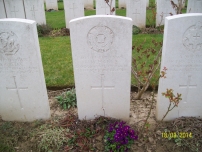| First Name: | Harry Wilfred | Last Name: | HALLS | |
|---|---|---|---|---|
| Date of Death: | 10/09/1916 | Lived/Born In: | Highbury | |
| Rank: | Rifleman | Unit: | London5 | |
| Memorial Site: | ||||
Current Information:Age-24 Enlisted-Hornsey Serre Road Cemetery2, Somme
The Battle of the Somme (July-November, 1916) By the beginning of September, 1916, the Battle of the Somme had been raging for two months. Thousands of men had already been killed or wounded or were simply missing, never to be seen again and and just a few square miles of the French countryside, all in the southern part of the battlefield, had been captured from the enemy. Mistakes had been made by the various commanders and would be continued to be made but there was no turning back as the British, Australians, South Africans, New Zealanders and Canadians carried on battering away at the German defences in the hope of a breakthrough, So it continued all the way through to November with nearly every battalion and division then in France being drawn into it at some stage. In the end the German trenches had been pushed back a few more miles along most of the line but the cost in lives had been staggering. By the end of the fighting in November, 1916, British Army casualties numbered over 400,000, killed, wounded and missing. On 1st July, 1916, 56th (London) Division, which included 5th London of 169 Brigade, had been heavily involved during the opening day of the Battle of the Somme when they attacked the German defences at Gommecourt on the northern edge of the battlefield. They remained in that sector until they moved south, to where the battle was raging, at the beginning of September. After the capture of Guillemont on 3rd September, the next target for the British was the village on Ginchy which was successfully taken by 16th Division on 9th September with 56th Division supporting them to the south. The day before, 169 Brigade had taken over the front line from the boundary with the French at Combles Ravine through to the southern portion of Leuze Wood. In the early hours of the morning of 9th September, 5th London and the bombers of 9th London had bombed their way 200 yards down Combles trench. But this success was short lived. By 5.15am, a counter-attack had forced them to withdraw. Their task on the afternoon of 9th September, when 16th Division attacked Ginchy, was to form a defensive flank along the slopes of the Combles Ravine and in order to accomplish this, 5th London attacked the sunken road that lay between Leuze Wood and Combles. This involved a flank attack through the wood and resulted in some very heavy fighting but they were unable to dislodge the enemy from Loop Trench. Eventually, those who still could, had to retire back to the wood. Here they remained, under constant artillery fire, until relieved during the night of 10th September. The casualty list for 5th London was very long with 350 names on it. One of these was Harry Halls. |
||||
| « Back to Search Results | ||||
| If you think any of the information shown here is incorrect, Click Here to submit your amends and comments | ||||




